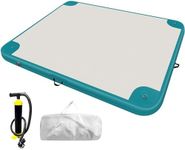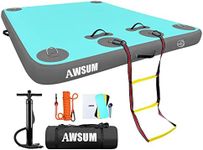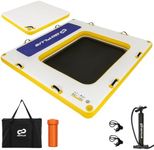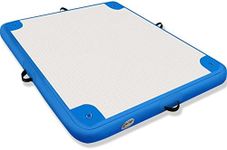Buying Guide for the Best Inflatable Dock
Choosing the right inflatable dock can make your time on the water much more enjoyable, whether you're relaxing, swimming, fishing, or using it as a platform for water sports. The key is to match the dock's features to your intended use, the number of people who will use it, and the environment where you'll set it up. By understanding the main specifications, you can confidently select a dock that fits your needs and ensures safety, stability, and fun.Size and CapacitySize refers to the length and width of the dock, while capacity is about how much weight it can safely hold. This is important because you want enough space for everyone and everything you plan to bring, like chairs, coolers, or water toys. Inflatable docks come in a range of sizes, from small platforms for a couple of people to large ones that can host a group. If you only need a spot to lounge or swim, a smaller dock may be enough. For parties or multiple activities, a larger dock with higher weight capacity is better. Always consider the number of users and the total weight (including gear) to avoid overloading.
Material and DurabilityThe material of an inflatable dock affects how long it will last and how well it stands up to rough use, sun, and water. Most docks are made from heavy-duty PVC or drop-stitch materials, which are strong and resistant to punctures. Thicker materials and reinforced seams mean better durability, especially if you plan to use the dock often or in areas with rocks or debris. If you want a dock for occasional, gentle use, standard materials may be fine. For frequent or rougher use, look for docks with extra reinforcement and UV protection.
Stability and ThicknessStability is about how steady the dock feels when people move around on it, and thickness plays a big role here. Thicker docks (usually 6 inches or more) are more stable and less likely to flex or tip, making them better for groups or active use. Thinner docks are lighter and easier to carry but may feel less solid. If you plan to stand, jump, or have several people on the dock, choose a thicker, more stable option. For sitting or lounging, a thinner dock may be sufficient.
Inflation and Deflation SystemThis refers to how you fill the dock with air and how quickly you can pack it up. Some docks have high-pressure valves and come with pumps that make inflation and deflation fast and easy. Others may take longer or require more effort. If you want convenience and plan to set up and take down the dock often, look for a model with an efficient pump and easy-to-use valves. If you’ll leave the dock inflated for long periods, this may be less important.
Attachment Points and AccessoriesAttachment points are built-in rings or loops that let you tie the dock to a boat, anchor, or other docks, and accessories can include ladders, handles, or storage bags. These features add safety and convenience, especially if you want to connect multiple docks, secure the platform, or make it easier to climb on and off. If you plan to use the dock in open water or with boats, look for plenty of strong attachment points. For simple use near shore, fewer accessories may be needed.
Portability and StoragePortability is about how easy it is to move and store the dock when not in use. Inflatable docks are generally lighter and more compact than traditional docks, but their packed size and weight can still vary. If you need to carry the dock to and from the water often, or have limited storage space, look for a model that packs down small and comes with a carrying bag. If storage and transport are not concerns, this may be less important.











